This year marks the 150th anniversary of the birth of Laura Ingalls Wilder, who brought a pioneer family to life in her Little House books. Follow along on this Midwestern tour for a glimpse back at the American frontier
When I was nine, fascinated by the Old West and sorry I’d been born too late for life as a pioneer, I discovered Laura Ingalls Wilder’s Little House series of books at our local library. The librarian suggested starting with Little House in the Big Woods in which Laura begins her story. I was hooked at the first sentence: “Once upon a time a little girl lived in the Big Woods of Wisconsin in a little gray house made of logs.” And as I read on, the life I dreamed of became wonderfully real.
Over the next few years, I read and reread the eight beloved Little House books. Simply and beautifully — in a style as compelling to adults as children — Laura recounts the story of her pioneer youth, bringing to life her earliest memories of big family gatherings in Wisconsin where she was born. Then, propelled by her restless father’s “itchy feet,” the family embarked on long journeys to unsettled land, traveling by covered wagon, which at the time seemed to me the best possible way to go.
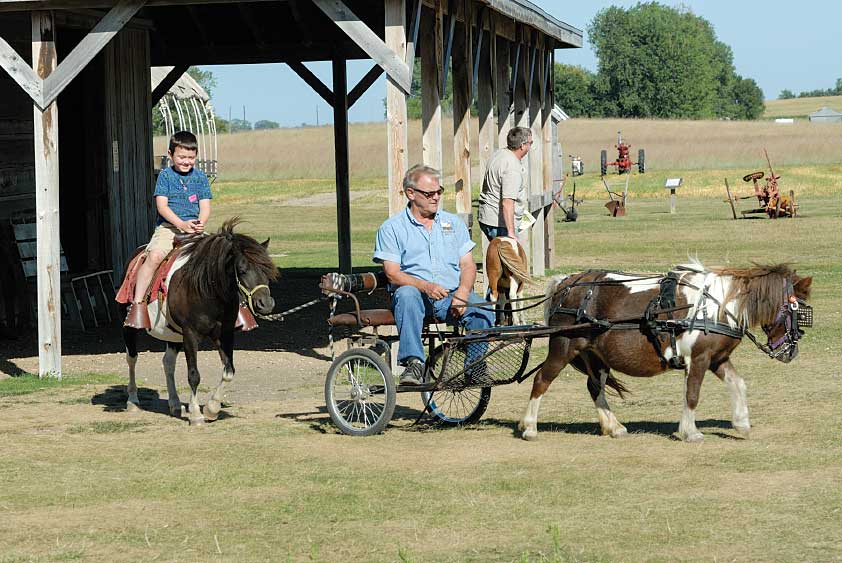
A guide at Ingalls Homestead just outside of De Smet, South Dakota, uses a pony-driven cart to take a young tourist for a pony ride.
Every year or two “Pa,” Laura’s father, Charles Ingalls, would load up his family and their few belongings, and off they’d go, traveling hundreds of miles (at roughly 2 miles
per hour) to new homes on the frontier, to live in a log cabin, a claim shanty on the prairie and a dugout on a creek bank. He liked staying ahead of civilization, though “Ma,” Laura’s mother, Caroline, would have preferred town life with school for their daughters, Mary, Laura, Carrie and Grace. Their only son, Charles Frederick, “Freddie,” died at less than a year when Laura was nine.
Years after my husband, Guy, and I had read the books to our own children, and watched the Little House on the Prairie TV series that ran from 1974 to 1983 and made Laura a household name, we decided it would be fun to follow a Laura Ingalls Wilder trail, visiting all the sites where she had lived.
There is a designated trail — the Laura Ingalls Wilder Historic Highway (U.S. Highway 14 plus side trips) that features five northern sites of her life in Pepin, Wisconsin; Spring Valley, Minnesota; Burr Oak, Iowa; Walnut Grove, Minnesota; and De Smet, South Dakota.
But the Ingalls family also lived elsewhere, and Laura, her husband, Almanzo Wilder (whose youth she describes in Farmer Boy), and their daughter, Rose, later moved several times (to Minnesota briefly, then Florida, back to Dakota and finally to the “Big Red Apple,” Missouri).
Ingalls’ childhood homesite can be visited in Mendon, Missouri, at 21876 Ingalls Road (660-256-3340, www.brunswickmo.com/visitor-info/thing-to-do-see). The Little House on the Prairie Museum (closed during winter months), near Independence, Kansas, has a replica of the family’s log cabin, an 1872 schoolhouse, a post office and gift shop (Independence Chamber of Commerce, 620-331-1890, 620-289-4238, www.indkschamber.org).
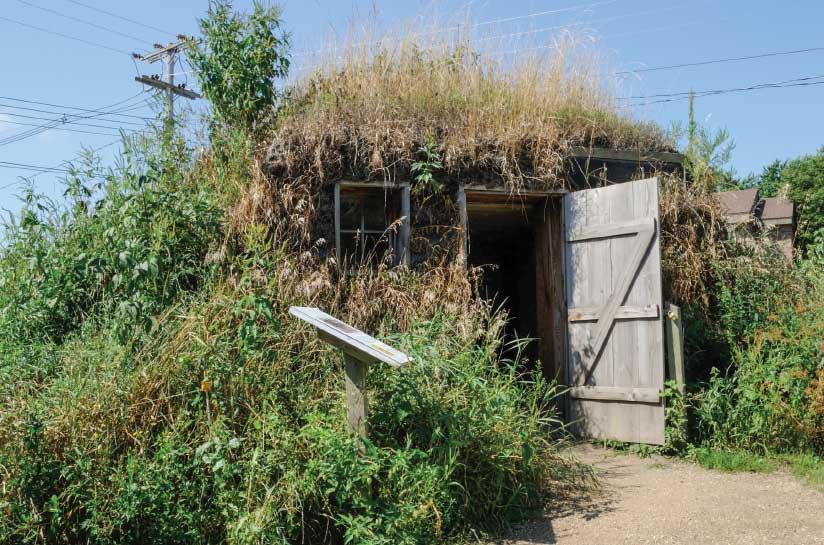
A re-created dugout gives an idea of the cramped quarters of the family home in On the Banks of Plum Creek. It is among the structures at the Laura Ingalls Wilder Museum in Walnut Grove, Minnesota.
At Rocky Ridge Farm near Mansfield, Missouri, where Laura and Almanzo moved in 1894 and lived the rest of their long lives, visitors “meet” Laura as an adult. It was here, in 1911, that she began writing articles and columns for newspapers and magazines. The first of her Little House books was published in 1932 when Laura was 65.
She doesn’t include dates in the books (which she said were “based” on her life), isn’t exact about locations and leaves out some of her family’s travels altogether. But at least seven of the places she lived — now historic sites — can provide maps and other information. For economy of miles, we suggest following her trail geographically rather than chronologically.
Our trip, following just the designated trail (though we’ve visited all the sites on other occasions), began in Pepin, Wisconsin, near where Laura was born on February 7, 1867. Pepin Historical Museum, aka the Laura Ingalls Wilder Museum, is here and displays a quilt Laura made. Other artifacts are “from her era” and include farming implements, kerosene lamps and a bison-skin coat, among others. Her books and the numerous spin-offs of them are available. The museum is open from May 15 to October 15 at 306 Third Street (715-513-6383, www.pepin wisconsin.com).
The Laura Ingalls Wilder Memorial Society manages the museum and also Little House Wayside, a 1974 replica of the Ingalls’ log cabin that is open year-round for self-guided tours on the original site 7 miles north of town on winding County Road CC. Now, fields of tall corn have replaced the Big Woods. But the humble 20-by-25-foot cabin, a “main” room with a fireplace, two smaller rooms and a loft, offers a glimpse into Laura’s pioneer childhood. A timeline of her Little House series and travels is tacked on one wall.
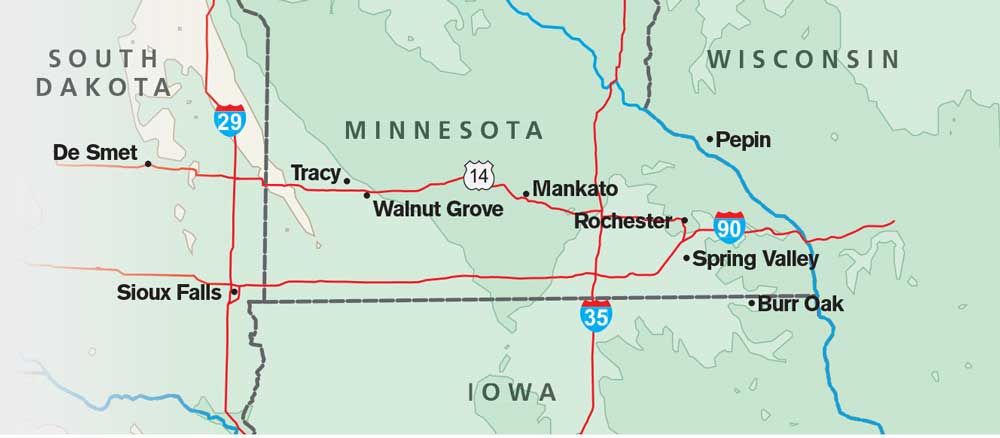
Where the Wilder Things Are
The Laura Ingalls Wilder Historic Highway spans several Midwestern states and connects five northern sites that were a treasured part of the author’s life. The route passes through Pepin, Wisconsin; Spring Valley, Minnesota; Burr Oak, Iowa; Walnut Grove, Minnesota; and De Smet, South Dakota. The official Little House on the Prairie website provides more details on these locations as well as other historic sites and museums related to the classic books and TV series.
www.littlehouseontheprairie.com/historic-locations-and-museum-sites
Pepin holds an annual Laura Ingalls Wilder Days (usually in September), which includes a Laura Contest, Olde Tyme Fiddle Competition, crafts demonstrations, quilt show, pioneer games and a horse-drawn wagon (www.lauradays.org).
The trail crosses the Mississippi River into Minnesota at Nelson, just south of Pepin and sky-blue Lake Pepin, a lake as sublimely beautiful as any you can imagine. It was frozen but near spring thaw when the Ingalls crossed. That night, Laura wrote, the ice began breaking up, cracking like gunfire.
Drive west 18 miles on Highway 60, south 35 miles on U.S. Route 63, then east 5 miles on Highway 16 to Spring Valley, the longtime home of Almanzo’s parents after they came west from New York. Laura and her family lived here from 1890 to 1891 and attended church with Almanzo’s family at the 1876 First Methodist Church, according to a source at the Spring Valley Historical Society.
In 1976 the church became a museum run by the historical society. Ornate with red and yellow brick, and stained-glass windows made in Italy in 1715, the building is on the National Register of Historic Places. Exhibits include 19th-century artifacts and Wilder family photos. There’s also a shop that sells gifts and books.
Across the street and part of the museum complex, the 1865 white-frame Washburn-Zittleman House displays early quilts, toys and 19th-century furnishings. The museum complex at 220-221 W. Courtland Street (507-346-7659, www.lauradays.orghttp://www.lauradays.org) is open from Memorial Day through Labor Day. Church tours are $5, and it’s $7 to tour all of the buildings (student discounts apply).
Though on private property and not open to the public, the Wilders’ barn, with a brown stone foundation and red door, is still standing at 702 Tracy Road, a short distance from the museum.
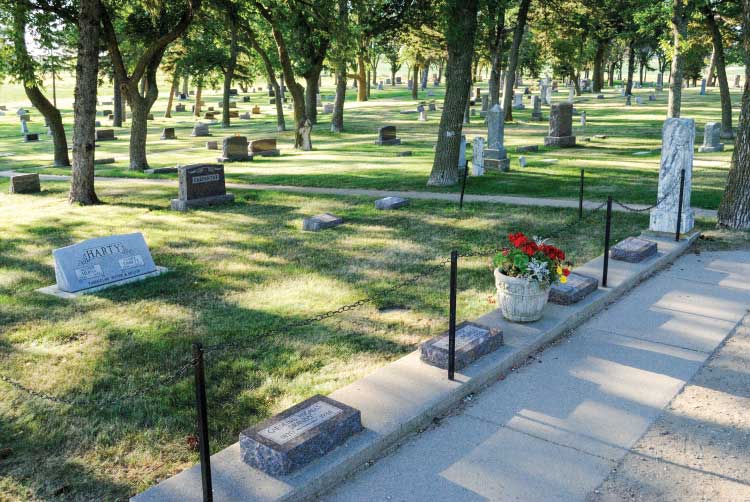
The Ingalls’ family plot at De Smet Cemetery in South Dakota. Laura and Almanzo are buried in Mansfield, Missouri.
From Spring Valley, it’s about 40 miles to Burr Oak, Iowa, where Laura’s childhood home is still on its original site; take Highway 16 east to U.S. Route 52 south. The Ingalls came here in 1876 from Walnut Grove, Minnesota, discouraged by two consecutive years of crop failures caused by grasshoppers and drought. En route, they stayed a short time with relatives at South Troy, Minnesota, where baby Freddie died.
Pa had found work managing the 1876 Masters Hotel in Burr Oak, and Ma, Mary and Laura cooked and cleaned at the 11-room white-frame establishment, now a museum. The family lived there and at two other sites (no longer standing) during their months in Burr Oak (not mentioned in her books). The youngest daughter, Grace, was born here, said museum director Steve Luse.
Life-size dolls of the Ingalls family, made by a local woman, now sit in the hotel’s front parlor. Outside, a picnic pavilion stands on a grassy slope near a covered wagon much like the one that brought the family here, and would take them back to Walnut Grove less than two years later. The museum is open from May through mid-October; tours cost $8 for adults and $6 for ages six through 17. A visitor center is across the street in the former Burr Oak Savings Bank at 236th Avenue (563-735-5916, www.lauraingallswilder.us).
Return to Highway 14 at Rochester and continue west 165 miles to Walnut Grove, which Laura describes in On the Banks of Plum Creek. The Ingalls family first arrived in 1874, having returned to Wisconsin from Kansas and staying three years before heading to Minnesota. The Laura Ingalls Wilder Museum in Walnut Grove is first-rate (866-305-2872 or 507-859-2358, www.walnutgrove.org/museum.html).
There’s a dugout, above ground but much like the Ingalls’, as well as a little red schoolhouse, a rustic chapel, and a two-room settler home that is similar to the “wonderful house” Wilder describes that Pa later built on Plum Creek. There’s also Grandma’s House, furnished with 19th-century artifacts, and Heritage Lane, where dozens of exhibits include a covered wagon illustrating pioneer-era travels. The museum offers hands-on experiences for children with a mercantile shop, bank and post office, and clothing, play money and groceries so kids can relive pioneer days.
The 1870s depot building displays other items, such as the buffalo coat that helped Pa survive three days in a snowbank during a blizzard, excerpts from Laura’s books, family photos, murals of Walnut Grove and more, including the bit of trivia that Laura
is distantly related to England’s Prince William.
There’s also an extensive gift shop, a butterfly garden, and two areas of “prairie plantings” where tall grasses are jeweled with asters, flox and other wildflowers to represent natural prairie. The museum at 330 Eighth Street is open daily from April through October, with extended hours in July and August. Admission is $7 for adults and $4 for ages 6 to 12.
Remains of the Ingalls’ dugout can be seen 1½ miles north of townoff County Road 5 on property now owned by farmer Stan Gordon (watch for the Ingalls Dugout Site sign on the right). To accommodate Wilder fans, Gordon has cut a path through his cornfields to the creek; it costs $5 to drive back (parking and turning around are adequate for a fifth-wheel).
A short walk through wildflowers leads to the “banks of Plum Creek.” What little is left of the dugout is in the bank on the opposite side. There’s a wood bridge and a path up a steep hill for views down on the ruins, where grass once grew on the roof.
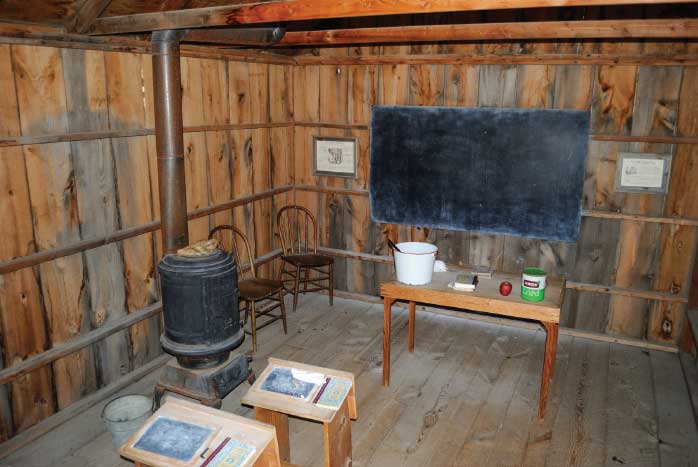
A re-creation of the Brewster School in De Smet where Laura taught.
An annual outdoor drama based on Laura’s life in Walnut Grove — The Wilder Pageant, now in its 41st year — is held just west of town. Dates for 2018 are July 6, 7, 13, 14, 20 and 21, with a family festival in the park on pageant Saturdays. General admission is $18 (888-859-3102, www.walnutgrove.org).
Ahead 7 miles at the west edge of railroad-town Tracy on Highway 14 is the Wheels Across the Prairie Museum, not on the “official” tour but worth a stop. Established in 1971, the museum began with a 1915 American steam engine, boxcar, caboose and historic depot, said founder Dorothy Pamp. A mannequin sits on a bench in the depot representing the real Laura, whose first train ride was from Walnut Grove to Tracy in the 1880s, Pamp said.
The museum, open seasonally starting the first weekend in May, is laid out like a small town and includes a historic barbershop, summer kitchen, 1860s log cabin, post office, blacksmith shop and chapel (507-626-1949, www.wheelsacrosstheprairie.org).
The trail continues west about 100 miles to De Smet, South Dakota — Dakota Territory when the Ingalls came in 1879 — where Pa had taken a job as timekeeper and paymaster with the Chicago and North Western Railroad. The Ingalls family briefly lived in an 8-by-10-foot claim shanty, and then in the six-room Surveyors’ House, a “mansion,” wrote Laura, their first winter in Dakota Territory. That spring, Pa got a homestead claim southeast of De Smet, said our tour guide of the Laura Ingalls Wilder Historic Homes.
Tours begin at the gift shop at 105 Olivet Avenue and include the Surveyors’ House, which was moved 1 mile west into town in 1884, four years after the Ingalls lived in it. Other sites include the one-room De Smet’s First School, attended by Laura and sister Carrie in 1880; a replica of the Brewster School where Laura taught; and the fine five-bedroom home Pa built on Third Street from 1887 to 1889. There, he, Ma and Mary, blind from age 14, lived the rest of their lives. Pa died in 1902, Ma in 1924, and Mary four years later. Laura, Carrie and Grace married and lived elsewhere. A Discovery Center is across the street from the gift shop, and visitors can dress up like pioneers and learn Braille. There are more than 2,000 original Ingalls-Wilder artifacts in the collection.
Sixteen other sites mentioned in Laura’s books are on a self-guided tour that includes the original Loftus Store, the site of Pa’s store (now an attorney’s office) that was home to the family during The Long Winter, and De Smet Cemetery southwest of town where Pa, Ma, Mary, Carrie and Grace are buried.
The Laura Ingalls Wilder Memorial Society runs the museums, which are open year-round. Admission is $12 for adults, $6 for ages six to 12, and children five and under are free
(800-880-3383, www.discoverlaura.org).
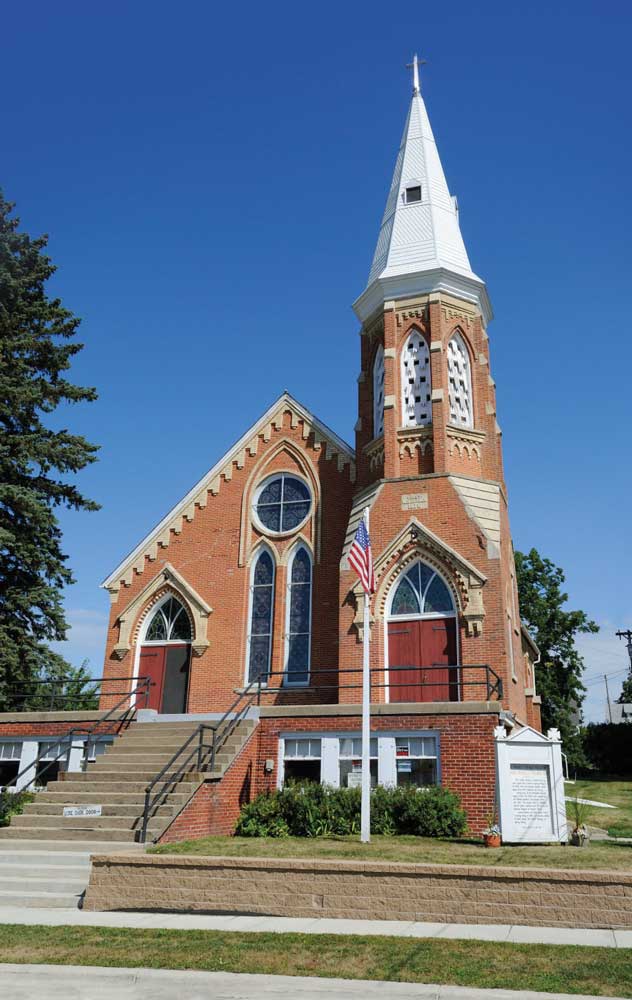
Laura Ingalls and her family lived in Spring Valley,
Minnesota, from 1890 to 1891 and attended church
with Almanzo Wilder’s family at the 1876 First
Mithodist Church.
An annual Laura Ingalls Wilder Pageant, an outdoor theater production, is held 1 mile southeast of town on Rose Lane. These Happy Golden Years, 2018’s event, will take place July 6 to 8, 13 to 15, and 20 to 22 (800-776-3594, www.desmetpageant.org).
Across the road, where the five cottonwoods Pa planted for Ma have grown huge, is Ingalls Homestead at 20812 Homestead Road, looking today much like it did after Pa had “proved” the land over seven years more than a century ago. Tim and Joan Sullivan bought the “shy” quarter-section (156 acres) in 1997 with the plan to let visitors — now more than 40,000 a year — “experience” pioneer life. Business hours for the homestead vary (800-776-3594 or 605-854-3984, www.ingallshomestead.com).
Ann Lesch, the Sullivans’ daughter, who works at the homestead, said previous owners had built the dugout, hay-roof barn and Ma’s furnished “little house.” Her parents added another barn that’s home to an array of cats, ponies and five teams of draft horses that take visitors for covered-wagon rides. They also moved a 1902 garage here from De Smet, and offer wheat-grinding, rope-making and other demonstrations of 19th-century life skills. The Sullivans plant wide fields with corn, wheat and oats to illustrate growing and harvesting, and have replanted stands of purple and yellow coneflowers, bluestem and buffalo grasses, common here in Laura’s day.
Horse-drawn covered wagons take groups of visitors to one-room Johnson School, built in 1889 and moved to the property in 1994. “Students” sit at 1860s desks while a “teacher” conducts lessons dressed in period attire.
The homestead includes an extensive gift shop. Four RV sites with full hookups ($30 per night) are available nearby; reservations are required. Four covered wagons and a bunkhouse are available for rental, and there’s tent camping as well. Nearby Lake Thompson Recreation Area (the lake is mentioned in several of Laura’s books) has pull-through and back-in sites.
Tim Sullivan said the homestead provides “a wonderful opportunity to teach history the hands-on way.”
He added, “This land has inspired a lot of stories.”
Laura Ingalls Wilder published five books about her years in Dakota: By the Shores of Silver Lake, Little Town on the Prairie, The Long Winter, These Happy Golden Years and The First Four Years. She once explained, “I wanted children now to understand more about the beginning of things, to know what is behind the things they see, what it is that made America as they know it.”

